Birmingham Airport
Birmingham Airport (IATA: BHX, ICAO: EGBB), formerly Birmingham International Airport[5] is an international airport located 7 nautical miles (13 km; 8.1 mi) east-southeast of Birmingham city centre, slightly north of Bickenhill in the Metropolitan Borough of Solihull, England.
Birmingham Airport | |||||||||||
|---|---|---|---|---|---|---|---|---|---|---|---|
 | |||||||||||
 | |||||||||||
| |||||||||||
| Summary | |||||||||||
| Airport type | Public | ||||||||||
| Owner | Seven Metropolitan Boroughs of West Midlands (49%), the Ontario Teachers' Pension Plan (48.25%) and employees (2.75%)[1] | ||||||||||
| Operator | Birmingham Airport Ltd | ||||||||||
| Serves | Birmingham, United Kingdom | ||||||||||
| Location | Bickenhill, Solihull, United Kingdom | ||||||||||
| Focus city for |
| ||||||||||
| Elevation AMSL | 341 ft / 104 m | ||||||||||
| Coordinates | 52°27′14″N 001°44′53″W | ||||||||||
| Website | birminghamairport.co.uk | ||||||||||
| Map | |||||||||||
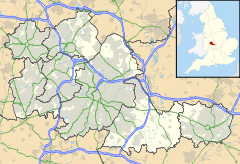 EGBB Location in the West Midlands 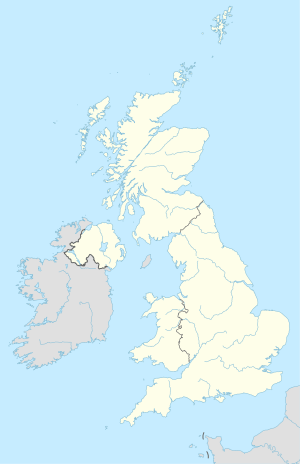 EGBB EGBB (the United Kingdom) | |||||||||||
| Runways | |||||||||||
| |||||||||||
| Statistics (2019) | |||||||||||
| |||||||||||
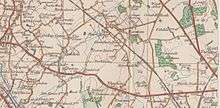
.jpg)
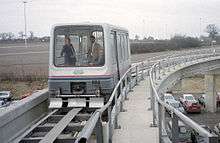

Officially opened as Elmdon Airport on 8 July 1939, the airport was requisitioned by the Air Ministry during Second World War and used by both the Royal Air Force (RAF) and the Royal Navy as RAF Elmdon. It was largely used for flight training and wartime production purposes. On 8 July 1946, the aerodrome was reopened to civilian operations.
Birmingham Airport currently holds a CAA Public Use Aerodrome Licence (Number P451) that allows flights for the public transport of passengers or for flying instruction. Passenger throughput in 2017 was over 12.9 million, making Birmingham the seventh busiest airport in the UK.[4][6] The airport offers international flights to destinations in Europe, the Middle East, the Indian subcontinent, North America, and the Caribbean. Birmingham Airport is an operating base for Jet2.com, Ryanair and TUI Airways.
Until 4 March 2020, the airport also offered an extensive domestic route network operated by the now defunct airline FlyBe [4][7] which operated a major base from the airport to Scotland, Northern Ireland, Channel Islands and the Isle of Man.
Location
Birmingham Airport is 5.5 NM (10.2 km; 6.3 mi) east-south-east of Birmingham city centre, in the Metropolitan Borough of Solihull. It is bordered by the National Exhibition Centre to the east, Marston Green to the north, Sheldon to the west, the village of Bickenhill to the south, and the village of Elmdon to the south west.
It is primarily served by the A45 main road, and is near Junction 6 of the M42 motorway. It is connected by the elevated AirRail Link with Birmingham International railway station on the West Coast Main Line.
The airport's location southeast of the city, plus the only operational runway being northwest–southeast (15/33), means that depending on wind direction, aircraft land or take-off directly over Birmingham. The former northeast–southwest runway (06/24) has been incorporated into the taxiway for aircraft accessing runway 15/33.
History
Construction and opening
In 1928, the Birmingham City Council decided that the city required a municipal airport; thus soon thereafter a committee was established to work towards establishing such a facility.[8] By 1931, several locations, including Shirley, Elmdon and Aldridge, were reportedly under consideration as potential sites. While Elmdon was considered to be an impressive and appropriate site for the airport, further progress was delayed due to spending cutbacks that had been initiated as a consequence of the Great Depression.[8] By 1933, the project was revived and a new airport committee was formed during the following year to oversee the airport's establishment. Prior to any major construction decisions being taken, members of the committee visited various successful airports around Europe in 1935, including Amsterdam, Berlin, Lyon, Paris, Brussels and London.[8]
During January 1935, the airport committee approached British architectural and engineering practice Norman and Dawbarn, inviting their attendance and seeking their participation as expert advisers on the airport's construction, the practice was subsequently appointed as the project's architects.[8] In 1933, Birmingham City Council authorised the compulsory purchase of 300 acres of land for the use by the airport; another 214 acres were similarly acquired during the following year. During 1936, a private bill presented by the Birmingham Corporation was passed through Parliament, which authorised the acquisition of further land as well as the diversion of various roads and footpaths to permit the airport's development. Shortly following the bill's passing, various agencies, including the City Engineer and Surveyor, the Public Works Department and a firm of aeronautical consultants, including Norman and Dawbarn, commenced work on preparing the ground, designing both the terminal and hangar buildings, and planning out the airport's detailed layout.[8]
By January 1937, Norman and Dawbarn had been authorised to finalise the design drawings; these were apparently completed by June 1937.[8] In October of that year, various contractors were appointed to construct various elements of the airport's buildings, including its elaborate terminal. Reportedly, the project's total expenditure amounted to around £360,000.[8] Construction work proceeded at a rapid pace; on 1 May 1939, the airport had been completed to such a degree that it was ready to handle traffic.[8]
On 8 July 1939, the Duchess of Kent, Princess Marina of Greece and Denmark, accompanied by the Prime Minister, Neville Chamberlain, officiated at the opening of Elmdon Airport.[9] Its terminal, which incorporated the airport's air traffic control tower, was designed by Norman and Dawbarn in an Art Deco style; this facility would continue to be used as a terminal until 1984 and subsequently as staff offices and for private flights; it is still intact as of 2018.[10][8] The airport was owned and operated by Birmingham City Council. Initial services flew to Croydon, Glasgow, Liverpool, Ryde, Shoreham, Manchester, and Southampton; further services were added soon thereafter, although its use as a civilian airport would soon be interrupted by the outbreak of the Second World War.[8]
Second World War
During the Second World War, Elmdon Airport was requisitioned by the Air Ministry and was used by both the Royal Air Force (RAF) and the Royal Navy as RAF Elmdon. It was largely operated as an Elementary Flying School and a base for the Fleet Air Arm.[8] It was during this era that the original grass airstrip was replaced by two hard runways: 06/24 at 2,469 feet (753 m) and 15/33 at 4,170 feet (1,271 m).[11] Large numbers of Avro Lancaster and Stirling bombers were manufactured at the Austin Aero Company's shadow factory at Cofton Hackett, but were unable to take off from the short runways at Longbridge; thus, they were transported by road to RAF Elmdon, their wings being removed beforehand and re-attached after arrival. They were test flown from the aerodrome and, once declared airworthy, they were flown to their operational units. On 8 July 1946, the aerodrome was reopened to civilian operations, though it remained under government control.[8][11]
1950 to 1980
During the post-war years, a number of public events, such as air fairs and air races, were held on the site. In 1949, scheduled services began with British European Airways (BEA) launching routes to Paris; the number of flights to the continent steadily grew over the years, including services to Zurich, Düsseldorf, Palma, Amsterdam and Barcelona commencing between 1955 and 1960. During 1960, the City of Birmingham resumed responsibility for the airport's operation again, ending central government control.[11]
In 1961, an additional terminal building to handle the growing international traffic was opened, which was fittingly called The International Building.[11] Furthermore, work to extend the airport's main runway to 7,400 feet (1.4 miles) was undertaken between 1967 and 1970, which permitted the launch of new services using turboprop and jet-powered airliners. Accordingly, a new service to New York using VC-10 airliner was launched during 1967.[11] By the early 1970s, Birmingham Airport was reportedly handling around one million passengers per year, albeit through a relatively congested passenger terminal. In 1974, the newly-formed West Midlands Metropolitan County Council took over management of the airport.[11]
On 16 September 1980, the supersonic airliner Concorde made its first visit to Birmingham Airport.[12] On 20 October 2003, Concorde made its final visit to the airport as part of its farewell tour.[13]
1981 to 2000
Birmingham Airport was once home to the world's first commercial maglev system in the form of a low-speed maglev shuttle that ran along a 620-metre line between the terminal and the nearby Birmingham International railway station.[14] Following a year of testing and trial use, the Birmingham Airport Maglev was opened to great fanfare during April 1984.[15] However, during 1995, the Maglev rail link was discontinued after 11 years; the closure has been attributed to the system's unreliability, it having suffered from frequent breakdowns. The original guideway lay dormant but intact for a time, while proposals for its restoration or adaption for other uses were considered.[16] In 2003, a replacement cable-hauled system, the AirRail Link Cable Liner people mover, was opened, which reused the track and much of the existing infrastructure.[17][18]
During 1993, the government limited public sector borrowing came into force and was applied to Birmingham Airport. This change meant that the airport could only expand by using private sector finance. 51% of the local council shares were sold to restructure the airport into a private sector company; this initiative led to the commencement of a £260 million restructuring programme in 1997.
2000s
During November 2007, Birmingham Airport published a master plan for its development up to 2030, called "Towards 2030: Planning a Sustainable Future for Air Transport in the Midlands".[19] This set out details of changes to the terminals, airfield layout and off-site infrastructure. As with all large scale plans, the proposals were controversial, with opposition from environmentalists and local residents. In particular, the requirement for a second parallel runway based on projected demand was disputed by opponents. Plans for a second runway (a third when demand requires) on the other side of the M42 and a new terminal complex and business park have been published, and they could help to create around 250,000 jobs. It has been estimated that if these plans went ahead, the airport could handle around 70,000,000 passengers annually, and around 500,000 aircraft movements.[20]
In January 2008, the shorter runway (06/24) was decommissioned. It had been used less often due to its short length, noise impact, and its inconvenient position crossing the main runway, making it uneconomic to continue operation. The closure also allowed for apron expansion on both sides of the main runway. However, runway 06/24 remains open as a taxiway and a helicopter airstrip.[21] In the same month, plans for the extension of the airport runway and the construction of a new air traffic control tower were submitted to Solihull Metropolitan Borough Council.
In June 2008, work began on building the new three-storey International Pier; it was officially opened on 9 September 2009. As part of the airport's 70th anniversary, the airport welcomed the Airbus A380 as the first user of the pier. The special service was the first commercial A380 flight in the UK outside London Heathrow Airport. The new pier is 240 metres long and 24 metres wide. Departing passengers are accommodated on the top level, with arriving passengers on the middle level and office accommodation for airline and handling agents on the ground floor. The new facility provides air-bridged aircraft parking for seven wide-bodied aircraft and enough space for 13 smaller aircraft. It can accommodate 'next generation' environmentally-efficient wide-bodied aircraft such as the Airbus A380, the A340-600, the Boeing 747-8, and the Boeing 777X. The new pier also has a new lounge for business class Emirates passengers.[22] In March 2009, the runway extension plans were approved.[23]
Since 2010
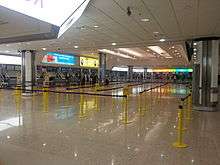
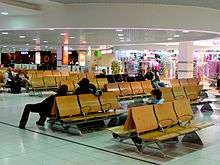
In September 2010, it was announced that after the merging of Terminals 1 and 2 into a single facility in 2011, the airport would drop the "International" from its official name to become "Birmingham Airport'".[24] A Midlands-based marketing agency was recruited to "create a new corporate identity that reflects Birmingham Airport's current position in the market place, as well as its future potential". Figures from Birmingham Airport show that 8 million people live within a one hour's drive of the airport, but less than 40% of them use it. It is hoped that the rebrand will make the airport "more visible to the market".[25] In November 2010, the new name started to be used.[26] The new logo, interlocking circles in shades of blue, and slogan, "Hello World", were designed to reflect the airport's new positioning as a global travel hub.[27]
In January 2011 the viewing gallery, 'Aviation Experience And Gift Shop', closed indefinitely.[28] In the same month, the airport merged its two terminals into a single terminal building, which involved the construction of two additional floors. A new lower ground floor accommodates the new Arrivals and Meet & Greet area, while the 3rd floor was built in the Millennium Link and the two terminals to accommodate the new Centralised Security Search area. In July 2011, construction of a new control tower began.[29] The new control tower was completed in March 2012; it replaced the airport's original tower, which had been used since the airport opened in 1939.
On 23 February 2011, Birmingham Airport announced that the High Speed 2 railway could be a solution to runway capacity problems in London; management figures suggested that it would be quicker to get to London from Birmingham than from Stansted Airport once completed, and claimed that the airport had capacity for nine million more passengers.[30]
Plans for the extension of the airport's runway, and the construction of the new air traffic control tower, were submitted to Solihull Metropolitan Borough Council in January 2008, and approved in March 2009.[23] Originally, the target for completion was in time for the 2012 London Olympics and Paralympics. An Olympic ceremony was held at the airport on 23 April 2012. The Olympic rings were unveiled on the tower and could be seen from the A45 road and the main terminal building. This was to commemorate the build-up to the London 2012 Olympic Games. These rings were removed once the Olympic Games officially closed, just before the 2012 Summer Paralympics began. Work on the new runway eventually began in autumn 2012.[31][32] The extension to the southern end of the runway originally required the A45 Coventry Road to be diverted into a tunnel under the extended section, but to cut costs, it was diverted south of the runway instead.[33] In Summer 2013 the new air traffic control tower became fully operational;[29] the old carriageway of the A45 was closed and the new carriageway was opened.[34][35] In May 2014, the 400-metre runway extension was officially opened;[31] the full length was first used on 22 July 2014, when China Southern Airlines operated its first charter between Birmingham and Beijing.[31]
The Ontario Teachers' Pension Plan, a Canadian institutional investor, increased its stake in the airport to 48.25% in early 2015. It also owns 100% of Bristol Airport.[36] Birmingham handled over 11.6 million passengers in 2016, a record total for the airport, making it the seventh busiest UK airport.[4]
On 28 September 2016, £100 million of investment was allocated to a new baggage handling system and two new car parks, including a drop-off car park.[37]
During the 2020 COVID-19 pandemic, a temporary mortuary was established in a hangar at the airport, with space for 12,000 bodies.[38][39]
Facilities and infrastructure
Birmingham Airport's current terminal complex is divided into two terminals, labelled as Terminal 1 and Terminal 2 and connected by the Millennium Link (building in 2000).
Terminal 1 was opened on 3 April 1984, seventeen years after the original plans to construct a new terminal to ease congestion in the original Elmdon Terminal (Grade II listed since August 2018 and used for private and official flights).[40][41] Since then, T1 has been extended multiple times to accommodate the increase in both passenger numbers and aircraft movements.
Terminal 2 (also known as Eurohub) was opened in 1991 and is served by several European carriers including Air France and KLM. British Airways' European and domestic operations also operate out of T2. In the terminal, check-in desks and the Arrivals area are located on the ground floor while security areas, shops, restaurants and bars are located on the first floor.
Airlines and destinations
The following airlines operate regular scheduled and charter services to and from Birmingham:[42]
| Airlines | Destinations |
|---|---|
| Aegean Airlines | Seasonal: Athens (resumes 2 June 2020)[43] |
| Aer Lingus | Dublin |
| Aer Lingus Regional | Cork, Dublin, Shannon |
| Air France | Paris–Charles de Gaulle |
| Air India | Amritsar, Delhi |
| Aurigny | Guernsey[44] |
| Austrian Airlines | Vienna Seasonal charter: Innsbruck[45] |
| BH Air | Seasonal: Burgas |
| Blue Air | Bacău (begins 17 June 2020),[46] Bucharest |
| Blue Islands | Jersey[47] |
| Brussels Airlines | Brussels |
| Eastern Airways | Aberdeen (begins 27 April 2020)[48] |
| easyJet | Belfast–International, Edinburgh,[49] Geneva, Glasgow,[50] Naples (begins 18 May 2020)[51] |
| Emirates | Dubai–International |
| Enter Air | Seasonal charter: Banjul,[52] Hurghada[53] |
| Eurowings | Düsseldorf |
| FlyEgypt | Seasonal charter: Hurghada[53] |
| Freebird Airlines | Seasonal charter: Dalaman[54] |
| Iberia Express | Madrid |
| Jet2.com | Alicante, Antalya, Barcelona, Budapest, Faro, Fuerteventura, Funchal, Gran Canaria, Innsbruck, Kraków, Lanzarote, Málaga, Malta, Palma de Mallorca, Paphos, Prague, Rome–Fiumicino, Tenerife–South Seasonal: Almería, Bergerac, Bodrum, Burgas,[55] Chania,[56] Corfu, Dalaman, Dubrovnik, Geneva, Girona, Grenoble, Heraklion, Ibiza, İzmir, Kefalonia (begins 6 May 2020),[56] Kos, Larnaca, Lisbon,[57] Menorca, Murcia (begins 22 May 2020),[56] Naples, Nice (begins 22 May 2020),[56] Pisa, Preveza/Lefkada (begins 24 May 2020),[57] Pula,[58] Reus, Reykjavík–Keflavík (begins 1 October 2020),[59] Rhodes, Salzburg, Santorini (begins 5 May 2020),[57] Skiathos (begins 13 May 2020),[57] Split, Thessaloniki, Turin, Venice, Verona,[58] Vienna, Zakynthos |
| KLM | Amsterdam |
| Lauda | Vienna[60] |
| Loganair | Aberdeen, Inverness |
| Lufthansa | Frankfurt, Munich |
| Pakistan International Airlines | Islamabad |
| Qatar Airways | Doha |
| Ryanair | Alicante, Barcelona, Bratislava, Bydgoszcz, Dublin, Faro, Fuerteventura, Gdańsk, Gran Canaria, Katowice, Kraków, Lanzarote, Madrid, Málaga, Malta, Murcia, Palma de Mallorca, Porto, Sofia, Tenerife–South, Verona, Warsaw–Modlin Seasonal: Chania, Corfu, Girona, Ibiza, Perpignan, Reus |
| Scandinavian Airlines | Copenhagen |
| Swiss International Air Lines | Zürich |
| Titan Airways | Seasonal charter: Chambéry,[61] Lourdes/Tarbes[61] |
| TUI Airways[54] | Agadir, Alicante, Boa Vista, Cancún, Enfidha, Fuerteventura, Gran Canaria, Hurghada, Lanzarote, Málaga, Marrakesh, Marsa Alam, Montego Bay, Paphos, Sal, Sharm El Sheikh, Tenerife–South Seasonal: Alghero, Almería (begins 3 May 2020),[62] Antalya, Banjul (begins 5 November 2020),[63] Barbados, Bodrum, Burgas, Catania, Chania, Corfu, Dalaman, Dubrovnik, Faro, Girona, Heraklion, Ibiza, İzmir, Kavala, Kefalonia, Kos, Langkawi,[64] Larnaca, Menorca, Naples, Orlando/Sanford, Palma de Mallorca, Pattaya–U-Tapao,[64] Podgorica, Porto Santo, Pula, Punta Cana, Reus, Rhodes, Rovaniemi, Salzburg, Santorini, Skiathos, Split (begins 1 May 2020),[62] Thessaloniki, Verona, Zakynthos Seasonal charter: Chambéry,[61] Innsbruck,[61] Kuusamo,[61] Sofia,[61] Toulouse,[61] Turin[61] |
| Turkish Airlines | Istanbul Seasonal: Antalya (begins 3 June 2020)[65] |
| Turkmenistan Airlines | Ashgabat |
| Vueling | Barcelona |
| Wizz Air | Bucharest, Budapest, Cluj-Napoca,[66] Kraków,[67] Poznań,[68] Warsaw–Chopin, Wrocław |
Statistics
Passenger figures
| Number of Passengers[69] | Number of Movements[70] | Birmingham Airport Passenger Totals 2000–2018 (millions) | ||
|---|---|---|---|---|
| 1997 | 6,025,485 | 79,880 | 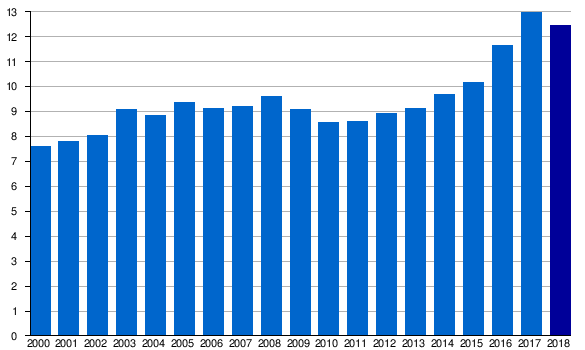 | |
| 1998 | 6,709,086 | 88,332 | ||
| 1999 | 7,013,913 | 98,749 | ||
| 2000 | 7,596,893 | 108,972 | ||
| 2001 | 7,808,562 | 111,008 | ||
| 2002 | 8,027,730 | 112,284 | ||
| 2003 | 9,079,172 | 116,040 | ||
| 2004 | 8,862,388 | 109,202 | ||
| 2005 | 9,381,425 | 112,963 | ||
| 2006 | 9,147,384 | 108,658 | ||
| 2007 | 9,226,340 | 114,679 | ||
| 2008 | 9,627,589 | 112,227 | ||
| 2009 | 9,102,899 | 101,221 | ||
| 2010 | 8,572,398 | 95,454 | ||
| 2011 | 8,616,296 | 93,145 | ||
| 2012 | 8,922,539 | 92,632 | ||
| 2013 | 9,120,201 | 95,713 | ||
| 2014 | 9,705,955 | 97,346 | ||
| 2015 | 10,187,122 | 98,015 | ||
| 2016 | 11,645,334 | 113,184 | ||
| 2017 | 12,983,436 | 122,067 | ||
| 2018 | 12,445,295 | 104,492 | ||
| 2019 | 12,639,340 | |||
| Source: UK Civil Aviation Authority[4] | ||||
Busiest routes
| Rank | Airport | Passengers handled | % Change 2017/18 |
|---|---|---|---|
| 1 | 923,343 | ||
| 2 | 710,517 | ||
| 3 | 703,047 | ||
| 4 | 412,080 | ||
| 5 | 383,348 | ||
| 6 | 367,867 | ||
| 7 | 357,780 | ||
| 8 | 333,730 | ||
| 9 | 321,985 | ||
| 10 | 275,477 | ||
| 11 | 270,446 | ||
| 12 | 267,695 | ||
| 13 | 253,213 | ||
| 14 | 252,079 | ||
| 15 | 249,657 | ||
| 16 | 234,522 | ||
| 17 | 218,425 | ||
| 18 | 209,484 | ||
| 19 | 176,874 | ||
| 20 | 149,776 |
Accidents and incidents
- 19 January 1973: A Vickers Viscount passenger jet G-AZLR inbound from Leeds Bradford Airport suffered a severe port undercarriage failure upon landing.[71]
- 23 February 2006: Mahan Air Airbus A310 operating a flight from Tehran, Iran, was involved in a serious incident while on approach to Birmingham International Airport. The aircraft descended to the published minimum descent altitude of 740 ft despite still being 11 nm from the runway threshold. At a point 6 nm from the runway the aircraft had descended to an altitude of 660 ft, which was 164 ft above ground level. Having noticed the descent profile, Birmingham air traffic control issued an immediate climb instruction to the aircraft, however, the crew had already commenced a missed approach, having received a GPWS alert. The aircraft was radar vectored for a second approach during which the flight crew again initiated an early descent. On this occasion, the radar controller instructed the crew to maintain their altitude and the crew successfully completed the approach to a safe landing. The accident investigation determined that the primary cause was use of the incorrect DME for the approach, combined with a substantial breakdown in the Crew Resource Management. Three safety recommendations were made.[72]
- 15 June 2006: A TNT Airways cargo 737-300 made an emergency landing at Birmingham with damaged landing gear.[73] The aircraft, registration OO-TND, had been flying from Liège in Belgium to London–Stansted. Due to poor visibility at Stansted the flight diverted to East Midlands Airport. As the weather at East Midlands was also poor, the aircraft performed a full autopilot approach. During this approach the autopilot momentarily disengaged causing it to deviate from the course. The aircraft hit the grass to the side of the runway, which caused the right main gear to detach. The crew initiated a go-around, declared an emergency and diverted to Birmingham. After it landed on Birmingham's main runway, the airport was closed for a number of hours. The pilots were unharmed.[74] However, the company ascribed the incident to human error and both pilots were dismissed.[75] The official report into the accident highlighted a number of factors contributing to the accident – poor weather forecast information; a message passed from the Air Traffic Control to the aircraft at an "inappropriate" time; the pilot accidentally disconnecting the autopilot when attempting to respond to the message; the pilot losing "situational awareness" and failing to abort the landing.[76] Follow this link for a more detailed report and Official reports from the AAIB.[77]
- 19 November 2010: A Cessna Citation aircraft, registration G-VUEM, crashed at Birmingham Airport during final approach in thick fog. Reports from West Midlands Police were that there were two casualties, one critical. The aircraft was bringing a human liver from Belfast airport, for a transplant operation which was subsequently completed successfully.[78] The airport reopened at around mid-day the following day. Follow this link for a more detailed report and Official reports from the AAIB.[79]
Security incidents
- 6 June 2007: The Tonight with Trevor McDonald programme exposed serious security flaws at Birmingham Airport over six months. Fifteen members of staff working for the security contractor "ICTS UK Ltd" were suspended and subsequently dismissed for gross misconduct.[80] Members of security were filmed asleep on duty, reading magazines whilst operating x-ray scanners, leaving aircraft unguarded, and ignoring bags sent for extra security checks, as well as being understaffed. The security lapse was deemed so serious, that Bennie Thompson, the chairman of the US Congress Homeland Security Committee, commented on it in the United States Congress and advised that all flights to and from Birmingham Airport should cease.[81] ICTS dismissed the members of staff shown in the programme for their actions, but still claimed that the footage had been "contrived to exaggerate and sensationalise" the issues.[82]
- 8 June 2009: The West Midlands Police helicopter (G-WMAO) was destroyed by arsonists,[83] and subsequently written off.[84] A year later, a new Eurocopter EC135 similar to G-WMAO was handed over to West Midlands Police at the Farnborough Airshow. Thousands of pounds were subsequently spent upgrading security surrounding the police helicopter.[85]
- 17 July 2014: A member of the public got onto the airfield through a restricted area of the terminal by crawling through the opening of a baggage carousel and getting onto the airport's tarmac apron, and then got aboard a Lufthansa Embraer 195 plane. He was subsequently fined.[86][87]
Ground transport

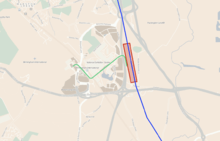
Public transport
Rail
Birmingham Airport is served by Birmingham International railway station. The station is on the West Coast Main Line between Birmingham and London, and trains are operated by West Midlands Trains, Avanti West Coast, TfW Rail, and CrossCountry. Access between the railway station and the airport terminal is provided by free AirRail Link.[88]
Proposed High Speed 2
As part of Phase 1 of the High Speed 2 rail link, a new railway station called Birmingham Interchange will be built to serve both the airport and the National Exhibition Centre. The station will be built on the far side of the M42 motorway and connect to the airport using a "rapid transit people mover". High Speed 2 is currently planned for completion by 2026.[89]
Bus and coach
National Express West Midlands operates the main bus routes calling at Birmingham Airport, those being the X1 to Birmingham city centre and Coventry, and the X12 to Chelmsley Wood and Solihull.[90] Other smaller operators also call at the airport. Bus stops are situated outside Terminal One.[91] Most buses are operated by National Express West Midlands.[92]
National Express Coaches operates various long distance coaches calling at Birmingham Airport on the way to or from Birmingham Coach Station.
Taxi
Black cabs are available at the taxi-rank outside the arrivals area of the terminal.
Car
Birmingham Airport is accessible from the north and south via Junction Six of the M42 motorway. From Birmingham city centre, the A45 runs directly to the airport. Charges apply in some areas even for very short periods of time, with locations farther from the airport being cheaper than those near the airport.
Bicycle
The only cycle route available heads south over the A45 travelling towards Solihull. Birmingham Airport has however published "recommended routes" for cyclists.[93] Free short term cycle parking is available close to the terminal. For longer stays, bicycles must be stored in the Left Luggage for a charge.[94]
See also
- Transport in Birmingham
References
- "Birmingham Airport". Airport Watch. Archived from the original on 4 January 2014. Retrieved 20 November 2013.
- "Birmingham Airport's Passenger Figures Round-Up for 2019". www.birminghamairport.co.uk.
- "NATS – AIS – Home". Retrieved 4 June 2015.
- "Aircraft and passenger traffic data from UK airports". UK Civil Aviation Authority. 3 March 2017. Archived from the original on 11 February 2017. Retrieved 14 March 2017.
- "We're Saying 'Hello World' As We Relaunch Our Brand". Birmingham Airport. Archived from the original on 7 November 2010.
- "Datasets – UK Civil Aviation Authority". www.caa.co.uk. Archived from the original on 11 February 2017. Retrieved 5 April 2016.
- "Datasets – UK Civil Aviation Authority". www.caa.co.uk. Archived from the original on
|archive-url=requires|archive-date=(help). Retrieved 5 April 2016. - Historic England. "Elmdon Terminal Building, Birmingham Airport (1458322)". National Heritage List for England. Retrieved 6 October 2019.
- "BIRMINGHAM". British Pathe. Retrieved 11 November 2011.
- "How historic Elmdon Terminal at Birmingham Airport has been saved". Birmingham Mail. 22 August 2018.
- "The History of Birmingham International Airport". Birmingham International Airport. Archived from the original on 9 October 2010. Retrieved 29 April 2008.
- "First Concorde visit to BHX 16/09/1980". Birmingham Airport Video Blog. 16 September 2013.
- "Birmingham Airport bids farewell to Concorde". BBC News. 20 October 2003.
- "The magnetic attraction of trains". BBC News. 9 November 1999.
- "World's first maglev operation moves into the test phase." Railway Gazette International, April 1983. pages 260-262.
- "New plan aims to bring the Maglev back". Birmingham Mail. Archived from the original on 22 May 2011. Retrieved 1 September 2006.
- "AirRail Shuttle Birmingham International Airport". DCC Doppelmayr. Retrieved 16 July 2008.
- "Birmingham International Airport People Mover". Arup. Archived from the original on 29 November 2007. Retrieved 11 July 2008.
- "Birmingham Airport Master Plan". Birmingham Airport. Archived from the original on 9 October 2010.
- "Birmingham Airport reveals vision of new runway". Birmingham Post. Archived from the original on 17 April 2016. Retrieved 21 April 2016.
- "Airport closes its oldest runway". BBC News. 28 December 2007. Archived from the original on 4 April 2014.
- "Emirates opens £1,3 million lounge for passengers at Birmingham". Birmingham Mail. Archived from the original on 23 March 2010. Retrieved 17 March 2010.
- "Runway Planning Notice". birminghamairport.co.uk. 24 July 2011. Archived from the original on 24 July 2011. Retrieved 23 August 2010.
- "Birmingham Airport changes name". Birmingham Mail. Archived from the original on 25 September 2010. Retrieved 23 September 2010.
- "New Agency to Manage Rebrand Announced". birminghamairport.com. Archived from the original on 22 September 2010.
- "Birmingham Airport (home page)". Archived from the original on 5 November 2010. Retrieved 4 November 2010.
- "Archived copy". Archived from the original on 13 August 2011. Retrieved 9 November 2010.CS1 maint: archived copy as title (link)
- "Plane spotting at Birmingham Airport". TMC Ltd. Archived from the original on 6 February 2006.
- "New Air Traffic Control Facility". Birmingham Airport. Archived from the original on 22 April 2016.
- "HS2 'will bring Birmingham Airport closer to London'". BBC News. 23 February 2011. Archived from the original on 24 October 2018. Retrieved 20 June 2018.
- Smith, Graham. "Birmingham Airport runway extension ready next week". Archived from the original on 14 July 2014.
- "Runway extension at Birmingham International Airport could be completed by 2012 Olympic Games". Archived from the original on 10 June 2016. Retrieved 21 April 2016.
- Cartledge, James. "Birmingham Airport runway scheme back on track". Archived from the original on 4 May 2016.
- "Birmingham Airport runway extension work starts". BBC News Online. 28 November 2012. Archived from the original on 1 December 2012. Retrieved 18 December 2012.
- "Preferred Contractor Announced for Runway Extension Scheme". Archived from the original on 13 May 2012.
- "Pension fund raises stake in UK's Birmingham Airport". 2 January 2015. Archived from the original on 7 March 2016. Retrieved 3 March 2016.
- "Birmingham Airport reveals plan for £100m investment". BBC News. Archived from the original on 9 November 2018.
- Parveen, Nazia; Walker, Amy (27 March 2020). "Temporary mortuary being built at Birmingham airport". The Guardian. Retrieved 5 April 2020.
- "Unfinished morgue already in use for virus deaths". BBC News. 7 April 2020. Retrieved 7 April 2020.
- Haines, Gavin (22 August 2018). "England reaches 400,000 listed buildings milestone – here are eight of the most curious". Daily Telegraph. Archived from the original on 22 August 2018. Retrieved 22 August 2018.
- Historic England. "Elmdon Terminal Building, Birmingham Airport (Grade II) (1458322)". National Heritage List for England.
- "Birmingham Airport Destinations and more". Archived from the original on 2 December 2018. Retrieved 1 December 2018.
- "2020: Αφετηρία για περισσότερα για την AEGEAN | About Aegean". Aegean Airlines.
- "New Routes | Aurigny - Guernsey's Airline". www.aurigny.com.
- "Timetable – myAustrian Holidays". myAustrian Holidays.
- Liu, Jim (13 January 2020). "Blue Air expands Bacau / Iasi network in S20". Routesonline.
- "Jersey & Guernsey flights, Fly from Bristol, East Midlands, London City, Newquay & Southampton - Blue Islands". www.blueislands.com.
- "Corona Virus Outbreak Information | Eastern Airways". www.easternairways.com.
- "EasyJet adds Birmingham route". Retrieved 18 September 2019.
- "easyjet announces new route from Birmingham Airport". Retrieved 14 August 2019.
- "New routes from the UK | easyJet". www.easyjet.com.
- "Flight Information". gambia.co.uk.
- "Red Sea Holidays updates Hurghada services after Thomas Cook collapse". travelweekly.co.uk. 10 October 2019.
- "Flight Timetable". tui.co.uk.
- 2018, UBM (UK) Ltd. "Jet2.com updates planned A321 network expansion in S19". Retrieved 29 March 2019.CS1 maint: numeric names: authors list (link)
- "Jet2.com S20 network expansion as of 26MAR19". routesonline.com. 27 March 2019. Retrieved 27 March 2019.
- Liu, Jim (22 January 2020). "Jet2.com S20 Network expansion as of 19JAN20". Routesonline.
- 2018, UBM (UK) Ltd. "Jet2.com outlines S19 network expansion". Retrieved 23 April 2018.CS1 maint: numeric names: authors list (link)
- "Jet2.com announces scheduled services from Birmingham Airport to Iceland for Winter 20/21". www.birminghamairport.co.uk.
- "Archived copy". Retrieved 27 March 2019.
- "Ski Holidays 2017/2018 – Get More Winter With Crystal Ski". Crystal Ski. Retrieved 21 August 2019.
- "TUI launch new Birmingham Airport flights with 194,000 seats up for grabs in 2020". birminghammail.co.uk. 22 October 2019.
- "Tui is adding new flights to Cuba and Gambia – two destinations previously served by former rival Thomas Cook". ttgmedia.com. 28 November 2019.
- "TUI Airways UK schedules new South East Asia routes in W18". routesonline.com. Retrieved 29 August 2018.
- Liu, Jim (14 January 2020). "Turkish Airlines S20 Europe/Russia service changes as of 13JAN20". Routesonline.
- 2018, UBM (UK) Ltd. "Wizz Air adds Cluj – Birmingham link from Dec 2018". Retrieved 6 July 2018.CS1 maint: numeric names: authors list (link)
- "WIZZ AIR LAUNCHES NEW LOW-FARE SERVICES FROM THE UK TO POLAND". birminghamairport.co.uk. 20 March 2019.
- "Archived copy". Retrieved 26 June 2019.
- Number of Passengers including domestic, international and transit.
- Number of Movements represents total takeoffs and landings during that year.
- Harro Ranter. "ASN Aircraft incident 19-JAN-1973 Vickers 813 Viscount G-AZLR". Archived from the original on 20 March 2015. Retrieved 4 June 2015.
- "Report on the serious incident to Airbus A310-304, registration F-OJHI, on approach to Birmingham International Airport on 23 February 2006". UK AAIB. Archived from the original on 11 March 2012. Retrieved 28 December 2007.
- "AAIB Report on OO=TND incident" Archived 9 February 2007 at the Wayback Machine
- Harro Ranter (15 June 2006). "ASN Aircraft accident Boeing 737-301F OO-TND East Midlands Airport (EMA)". Archived from the original on 15 March 2012. Retrieved 4 June 2015.
- ""BBC News article, 27 July 2006 – Cargo plane crash pilots sacked"". Archived from the original on 14 March 2007. Retrieved 27 July 2006.
- "Cargo flight 'a near catastrophe'". BBC News Online. 29 April 2008. Archived from the original on 1 May 2008. Retrieved 29 April 2008.
- "Accident description". Archived from the original on 15 March 2012. Retrieved 24 June 2016.
- "Birmingham airport plane crash: Liver transplant operation goes ahead successfully – Top Stories – News – Birmingham Mail". Archived from the original on 23 November 2010. Retrieved 20 November 2010.
- "Cessna 501 Citation, G-VUEM, 19 November 2010 – GOV.UK". www.gov.uk. Archived from the original on 5 February 2017. Retrieved 13 July 2017.
- "Airport at centre of security row". Birmingham Mail. 4 June 2007. Archived from the original on 23 July 2011. Retrieved 12 March 2010.
- "AIRPORT SECURITY WHO WOULD RATHER READ SLEEP THAN X-RAY BAGS". The Express. Archived from the original on 11 January 2012. Retrieved 12 March 2010.
- "Airport security lapses exposed". BBC News. 4 June 2007. Archived from the original on 15 February 2009. Retrieved 12 March 2010.
- "Arson attack on police helicopter". BBC News. 8 June 2009. Retrieved 22 May 2010.
- "Aircraft registration". Archived from the original on 6 June 2011. Retrieved 2 June 2010.
- "west midlands police ready to take off with new chopper". Birmingham Mail. July 2010. Archived from the original on 24 July 2010. Retrieved 22 July 2010.
- "Man accused of Birmingham Airport security breach". BBC News. Archived from the original on 28 January 2019. Retrieved 20 June 2018.
- "Drunk stowaway said he was co-pilot". BBC News. 20 August 2014. Archived from the original on 21 November 2018. Retrieved 20 November 2018.
- "Birmingham International Station". Birmingham Airport. Archived from the original on 29 May 2010.
- "High Speed Rail Command Paper" (PDF). DfT.
- "Network West Midlands". Route 97. Archived from the original on 1 April 2013. Retrieved 10 March 2013.
- "Coach or Bus". Birmingham Airport. Archived from the original on 30 May 2010.
- One Black Bear. "Cash Fares – Single Journeys". Archived from the original on 26 April 2015. Retrieved 4 June 2015.
- "recommended cycle routes". Birmingham Airport. Archived from the original on 25 July 2010.
- "By Bike". Birmingham Airport. Archived from the original on 30 May 2010.
External links
![]()
- Official website
- Airport Consultative Committee
- Birmingham Airport companies grouped at OpenCorporates
- Opening ceremony, 1939 Pathé Newsreel